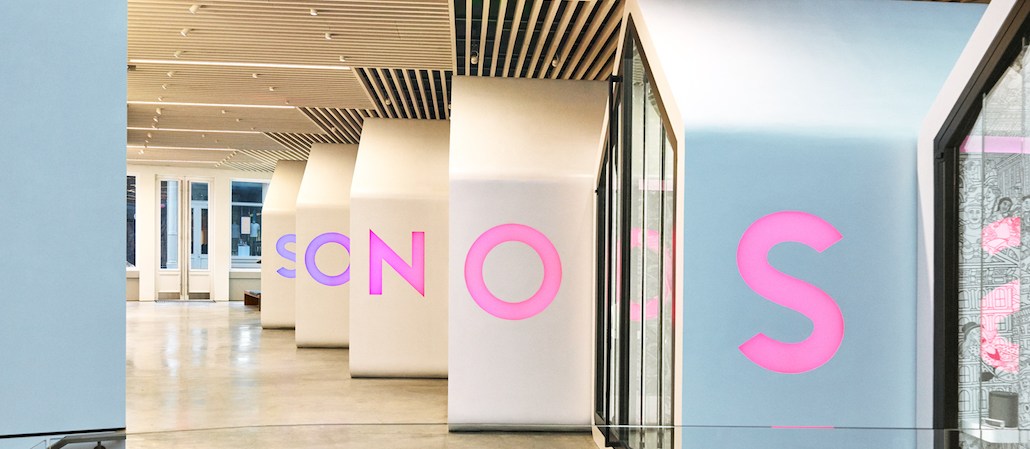Save 50% on a 3-month Digiday+ membership. Ends Dec 12.

This is ThinkTank, a series in which we quiz brand chiefs and CMOs on where the industry is heading.
Sonos faces a marketing challenge: Many people believe it’s complicated and the product itself is best experienced to understand its benefits.
On Tuesday, the company opened its first retail shop in Soho. The 4,200-squrae-foot store features seven state-of-the-art listening rooms. Each room was built with four layers of acoustic sheet rock and steel-framed glass door to ensure sounds are contained within the individual space. The move is part of a marketing shift that emphasizes high-touch experiential efforts over broadcast TV, according to Joy Howard, the CMO for Sonos.
“We will continue to buy media, but we will invest more in experience and refresh our point of sale,” Howard explained. “You will see us returning to the basics in marketing because people are hungry for straightforward product communication.”
More of what she said, lightly edited for clarity:
Sonos is trying so hard to educate people on how simple it is to use.
One big hurdle for Sonos: People think it’s hard to use. In order to help music lovers understand the brand, Sonos is redesigning its website and plans to use social media to emphasize the simplicity message.
The company is also advertising on home and design magazines for the first time this year. This is because people think a lot about how to design their homes but few think about how they can design the sound of their homes. Howard wants to tell consumers that Sonos is the first option if they want to have a home sound system.
“Our brand is different. Beats is great when you are young and Bose is really a pioneer in sound engineering. We are focused on sound too but we are 100 percent designing a music system for your home,” said Howard.
Sonos will learn from Apple as much as it can.
Sonos is taking a cue from Apple whose physical stores have fundamentally turned consumers’ buying conversations into a 360-degree valuation of product experience.
“People buy Sonos because they usually listen on it at their friends’ house. We really want to recreate that home experience,” said Howard. “When people want to buy a sound system for their home, they really want to hear it and touch it first. They just cannot do that online.”
Howard hopes that the first Sonos retail store can help the brand build a deeper relationship with its consumers, just like Apple Store. If it can help the brand improve consumer experience and further drive more sales, Sonos plans to open more stores in the U.S..
“I personally like Apple’s Angela Ahrendts. We will learn from Apple as much as we can but there are certain things that only we can do,” said Howard.
Perhaps a well-rounded shopping experience involves both online and offline. E-commerce conglomerate Amazon opened its first physical book store in late 2015 and is looking to expand its physical footprint. Menswear e-tailer Bonobos also opened a showroom in Manhattan last July to let consumers try on its pants and polos, and then make a purchase online. Brick-and-mortar shops have proven successful for those companies and money pours in.
Sonos is focused on streaming service usage.
While Sonos has formed great partnerships with Spotify, Pandora, Tidal, Apple Music and other music streaming services, the company doesn’t plan to analyze artists at an individual level through those partnerships. Musicians from those streaming services do constantly participate in Sonos’ product development though, so the company can “deliver the music to you the same way that the artist wants you to hear.” Rick Rubin and Q-Tip – who are on Sonos’ board of advisers – also participate in the design of the company’s first retail store.
“Predicting artists is not something we have done yet. We are focused on what streaming service brings Sonos more customers,” said Howard. “If you are a Spotify user, for example, you listen to the platform twice as much if you are using Sonos.”
More in Marketing

In Graphic Detail: Here’s what the creator economy is expected to look like in 2026
Digiday has charted its expected revenue, key platforms for creator content as well as what types of creators brands want to work with.

Ulta, Best Buy and Adidas dominate AI holiday shopping mentions
The brands that are seeing the biggest boost from this shift in consumer behavior are some of the biggest retailers.

Future of Marketing Briefing: AI confuses marketers but their own uncertainty runs deeper
That was the undercurrent at this week’s Digiday Programmatic Marketing Summit in New Orleans.





